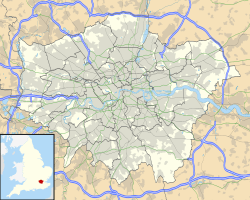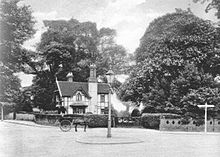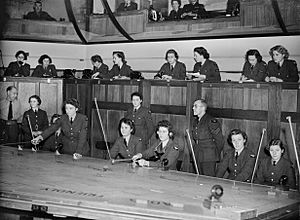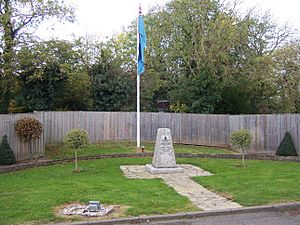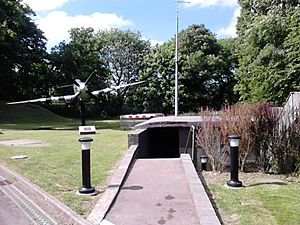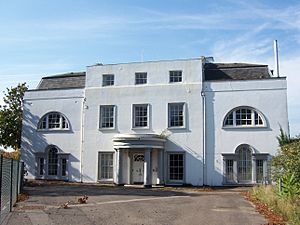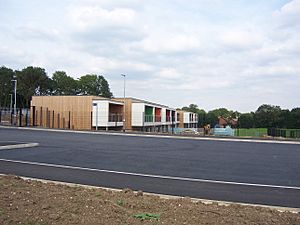RAF Uxbridge facts for kids
Quick facts for kids Royal Air Force Uxbridge
|
|
|---|---|
| Uxbridge, Hillingdon, Greater London Near Uxbridge in UK |
|
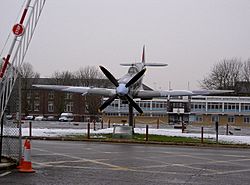
A full-size model Spitfire gate guard at the entrance to RAF Uxbridge.
|
|

|
|
|
Location within Greater London
|
|
| Coordinates | 51°32′32″N 0°28′11″W / 51.54222°N 0.46972°W |
| Type | Non-flying administrative, headquarters and support station |
| Area | 46 hectares (110 acres) |
| Site information | |
| Owner | Ministry of Defence |
| Operator | Royal Flying Corps (1917–1918) Royal Air Force (1918–2010) |
| Open to the public |
Yes (Battle of Britain Bunker) |
| Condition | Closed |
| Site history | |
| Built | 1917 |
| In use | 1917–2010 |
| Fate |
|
| Battles/wars | Battle of Britain Evacuation of Dunkirk Preparation for D-Day Normandy Campaign |
RAF Uxbridge was a special base for the Royal Air Force (RAF) in Uxbridge, London. It was built on land that used to be part of the Hillingdon House estate. The British Government bought this land in 1915, a few years before the RAF was even created. Before the Second World War started in 1939, people could visit the station.
This base is most famous for being the main office of No. 11 Group RAF. This group was in charge of defending London and south-east England from air attacks during the Battle of Britain. Hillingdon House was their main building. A secret underground bunker, now called the Battle of Britain Bunker, was built nearby. This bunker held the 11 Group Operations Room, which controlled all the fighter planes in the area. This room also helped plan air support for the evacuation of Dunkirk in May 1940 and the D-Day landings. It was here that Winston Churchill first said his famous words: "Never in the history of mankind has so much been owed by so many to so few". He repeated this in a speech to Parliament a few days later.
RAF Uxbridge closed on March 31, 2010. This was part of a plan to reduce the number of Ministry of Defence bases in London. Many of its military groups moved to nearby RAF Northolt the next day. Plans to build new homes and shops, while keeping the old historic buildings, were approved in 2011. A small part of the base, including the Battle of Britain Bunker, still keeps the RAF Uxbridge name and is now owned by Hillingdon Council.
The River Pinn flows through the site. The land around the river is mostly wooded and protected as greenbelt land. Hillingdon Golf Course is next to the southern part of the base. A walking path through the site, which had been closed since 1988, was reopened in 2011.
Contents
History of RAF Uxbridge
Early Days of Hillingdon House
The land where RAF Uxbridge was built used to be part of the Hillingdon House estate. The house itself was first built in 1717 as a hunting lodge. It was owned by the Duke of Schomberg, a German general who served under King William III.
Over the years, the estate changed hands many times. In 1786, the Marchioness of Rockingham bought the house. Later, in 1810, it was sold to Richard Henry Cox, whose family founded the travel company Cox & Kings. The original mansion burned down in 1844 but was completely rebuilt. This new building is now a protected historic site.
First World War and the RAF's Start
In 1914, Hillingdon House and its large gardens were put up for sale. The British Government bought the estate in 1915. They first planned to use it as a prisoner of war camp, but local people didn't like this idea. So, it became the Canadian Convalescent Hospital instead. This hospital cared for soldiers who were hurt during the First World War.
On November 19, 1917, the Royal Flying Corps Armament School moved into Hillingdon House. They used parts of the estate that the hospital didn't need. They even built firing ranges along the River Pinn to train new recruits in ground gunnery. The hospital closed in December 1917.
A very important day for the base was April 1, 1918. This was the day the Royal Air Force was officially formed. The Uxbridge site then came under the control of the new RAF. The very next month, King George V visited the base, making it the first RAF station to receive a royal visit!
Between the World Wars
After the First World War, in August 1919, the Recruits Training Depot moved to Uxbridge. This meant that many new RAF recruits came here for their basic training. The base became known as RAF Central Depot, Uxbridge. Later, the site was split into two parts: RAF Hillingdon and RAF Uxbridge.
The station cinema, designed by Lieutenant J. G. N. Clift, opened in 1919. It was first used as a lecture hall for new recruits. The RAF School of Music also moved to RAF Uxbridge in September 1919.
A famous person, T. E. Lawrence, also known as "Lawrence of Arabia," trained at the Uxbridge Depot in 1922. He joined the RAF under a different name and wrote about his experiences in a book called The Mint.
In 1925, new barrack blocks were built around the parade ground. The RAF officers' hospital and the first Operations Room were also built. The Air Ministry chose RAF Uxbridge as the new base for the Air Defence of Great Britain (ADGB) in 1926. This was because it was close to London but still on the edge, making it harder for enemies to find and bomb. The station cinema, which was first for military use, soon opened to the public.
The original Operations Room was made of wood, which caused problems in winter. A memo in 1933 suggested that the Operations Room needed to be moved underground. This was to protect it from bombs and to keep the equipment working in damp conditions.
Douglas Bader, a famous pilot, came to the military hospital in 1932. He was recovering after losing his legs in a plane crash. While there, he met the Desoutter brothers, who made lightweight artificial legs. With these new legs, Bader worked hard to regain his abilities. He learned to drive a special car, play golf, and even dance. He later became a hero in World War II.
On May 1, 1936, No. 11 Group RAF was formed and based at RAF Uxbridge. This group was very important for air defence. The ADGB was reorganized, and control of fighter planes went to the new RAF Fighter Command.
Planning for the new 11 Group Operations Room, which became the Battle of Britain Bunker, started in 1937. It was built 60 feet underground by Sir Robert McAlpine and could survive a 500-pound bomb hit. Work began in February 1939 and finished in August, just before the Second World War began. The old Operations Room on the surface became a backup. In August 1939, the new Operations Room and RAF Uxbridge were ready for war. The station closed to the public when the war started.
Second World War Heroics
During the war, RAF Uxbridge was very busy. It sent personnel to and from training and operational units in Northern France. It also had a language school where Polish Air Force pilots learned important RAF codewords. Pilots even practiced formation flying on the station's football pitch using tricycles!
When British troops returned from Dunkirk, they were processed at Uxbridge. In mid-1940, the station handled about 2,500 new recruits and experienced troops every week.
The most famous time for RAF Uxbridge was during the Battle of Britain (July to October 1940). Warnings about air threats came to RAF Bentley Priory, which then sent them to the Operations Room at RAF Uxbridge. From there, 11 Group decided which defence resources to use and sent orders to its airfields. The number of 11 Group personnel grew to 20,000 during this time. The RAF officers' hospital became the Women's Auxiliary Air Force (WAAF) hospital.

Air Vice Marshal Keith Park, who was in charge of operations at RAF Uxbridge, stayed in a house near the bunker entrance. He used a small door to get to the bunker every day. This house was later named Park House in his honor.
Prime Minister Winston Churchill visited the station on August 16, 1940, to watch the battle from the Operations Room. After leaving, he made his famous comment, "Never in the field of human conflict was so much owed by so many to so few." He repeated this quote in a speech to Parliament four days later. King George VI and Queen Elizabeth also visited the station on September 6. Churchill returned on September 15, 1940, which was the toughest day of the battle, now called Battle of Britain Day.
The station was attacked a few times by bombs, but luckily, not many fell directly on the base. Some pilots might have mistaken glass greenhouses nearby for a large body of water.
The king and queen returned on November 1, 1941. A "Royal Box" was even put in the Operations Room so they could watch the plotting activities. In 1942, famous visitors included General Charles de Gaulle, Sir Anthony Eden, and Lord Mountbatten. Some actors, like Rex Harrison, also served in the Operations Room during the war.
11 Group was also involved in providing air support for the Dieppe Raid in August 1942. The air operations for Operation Overlord—the Normandy landings on D-Day, June 6, 1944—were also controlled from RAF Uxbridge. Orders from this station were the only ones given to Allied air units on that important day.
After the War: New Roles and Closure
After the war, RAF Uxbridge became an athlete's village for male competitors in the 1948 Summer Olympics. Swimmers trained at the nearby Uxbridge Lido.
In 1949, the RAF Cricket Association opened on the station grounds. The station's badge was approved in 1953. It showed a drill sergeant's pace stick, representing recruit training, and a bugle, representing the Central Band of the RAF.
The ceremonial entrance, St Andrew's Gate, opened in 1957. A memorial to the 11 Group personnel, made of Cornish granite, was placed above the Operations Room. The 11 Group moved to RAF Martlesham Heath in 1958, and the Operations Room was sealed in its original condition. The memorial was unveiled by Air Chief Marshal Lord Dowding in a special ceremony.
In 1960, the station was given the Freedom of the London Borough of Hillingdon. This honor allowed the station's personnel to march through the borough in uniform. The Queen's Colour Squadron of the RAF Regiment also moved to Uxbridge in November 1960.
The 11 Group Operations Room was carefully studied to build a replica for the 1969 film Battle of Britain. Scenes for other TV shows were also filmed in the actual Operations Room. In 1975, the Operations Room was restored by 9 Signals Unit. The original map was repaired, and the board showing squadron readiness was rebuilt to look like it did on September 15, 1940. In 1985, a museum was created inside the bunker, and the Operations Room opened for group visits.
In January 1981, the Provisional Irish Republican Army (IRA) planted a bomb in a barrack block at RAF Uxbridge. Luckily, it was found, and everyone was evacuated before it exploded. The station also played a role in the Falklands War in 1982 and Operation Granby during the Gulf War in 1990. Support groups for families of service personnel were set up at the station.
The station church, St Luke's, had to move in the 1990s because its wooden foundations failed. A new sports center opened in October 1995. RAF Uxbridge personnel were also prepared for Operation Telic in Iraq in 2003.
On November 28, 2007, personnel paraded through Uxbridge town center, showing off their freedom of the borough. RAF Uxbridge became a smaller, satellite station of RAF Northolt in 2008, getting ready for its eventual closure. The Queen's Colour Squadron returned from Afghanistan in 2009, with a homecoming parade through Uxbridge town center that over 20,000 people watched.
RAF Units at Uxbridge
Many different RAF units were based at Uxbridge over the years. Here are some of the most important ones:
| Unit | Dates |
|---|---|
| RAF Depot | October 1918– |
| HQ, No. 2 Group RAF | July 7, 1919 – March 31, 1920 |
| No. 1 Squadron RAF | September 19, 1919 – January 21, 1920 |
| No. 24 Squadron RAF | September 19, 1919 – February 1, 1920 |
| HQ, Southern Area | September 20, 1919 – April 1, 1920 |
| HQ, Air Defence of Great Britain | June 1, 1926 – July 13, 1936 |
| HQ, Bomber Command | July 14, 1936 – March 13, 1940 |
| HQ, No. 11 Group RAF | May 1, 1936 – 1948 |
| No. 1 Personnel Transit Centre | August 23 – September 6, 1939 |
| HQ, 2nd Tactical Air Force | February 1 – August 20, 1944 |
| Queen's Colour Squadron | November 1960 – January 2010 |
Closure and New Beginnings
Before RAF Uxbridge closed, Queen Elizabeth II sent a message to the station in February 2010. She was happy that the historic 11 Group Operations Rooms Bunker would be saved as an RAF asset. She hoped it would continue to remind people of those who fought in the Battle of Britain.
The station officially closed on March 31, 2010. This was part of a plan to reduce military sites in London. The closing ceremony included parades and the final lowering of the Royal Air Force Ensign. A Supermarine Spitfire even flew over the station. The remaining units marched to their new home at RAF Northolt the next day.
The Air Training Corps (ATC) squadron, 1083 Squadron, which was based at Uxbridge, adopted the station's badge. They continued to meet at the station for a few months before moving to a new building.
The historic Battle of Britain Bunker is now a museum open to the public. Hillingdon House will be partly turned into a restaurant. The station cinema is also a protected building. The Battle of Britain War Memorial is a scheduled monument. Other buildings, like the Officers' Mess, will also be kept. St. Andrew's Gate will remain, as will the Mons barrack block.
Plans to develop the rest of the site were approved in January 2011. This includes building 1,340 homes, shops, a theatre, and a primary school over ten years. The council wants this area to become an extension of Uxbridge town center.
The area around the Battle of Britain Bunker, including the 11 Group memorial, will still be called RAF Uxbridge. It will be looked after by RAF Northolt. The Royal Air Force Ensign and the Supermarine Spitfire gate guardian were moved to this area. The Spitfire, a fiberglass replica, was repainted in D-Day invasion colors. Uxbridge's first gate guardian was a real Spitfire, unveiled in 1973. In September 2010, a new Hawker Hurricane gate guardian was unveiled near the bunker. This is also a fiberglass replica, painted in the colors of 303 Polish Fighter Squadron.
The South Hillingdon branch of the St. John Ambulance service, which was based at RAF Uxbridge, found new premises at RAF Northolt.
In June 2011, a public walking path from St Andrew's Gate to Vine Lane was reopened. This path, 800 meters long, had been closed since 1988.
Since closing, the site has been used for filming. Scenes for the TV drama Endeavour were filmed there.
In April 2012, VSM Estates bought the site from the Ministry of Defence to start building work. Demolition of some parts of the site began in October 2012. The new development will be called St Andrew's Park.
A wood was planted on the site in May 2012 to celebrate the Diamond Jubilee of Elizabeth II. Each school in Hillingdon was invited to plant a tree.
A special ceremony was held on July 2, 2013, to mark the start of the development. A new primary school, called the John Locke Academy, opened on the site in September 2014. It will have places for 630 primary students and 90 nursery students.
See also
- List of Battle of Britain airfields
- List of former Royal Air Force stations


